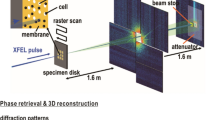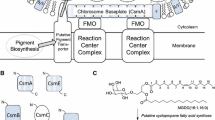Abstract
Freeze-fracture electron microscopy has been used to investigate the size, form, distribution and supramolecular organization of chlorosomes (chlorobium type vesicles) in Chloroflexus aurantiacus J-10fl, a phototrophic, filamentous gliding bacterium. The chlorosomes, that appear tightly attached to the cytoplasmic membrane, have the form of flat, elongated sacs with rounded ends, and measure 106±24×32±10×12±2nm. They are randomly distributed, and in most instances their longitudinal axis makes an angle of 30–60° to the filament axis. Each chlorosome consists of a core and an approx. 2 nm thick envelope. The core is filled with rod-shaped elements (approx. 5.2 nm in diameter) made up of globular subunits with a periodicity of approx. 6 nm. The rod elements extend the full length of the chlorosome. The membrane-associated envelope layer is marked by extremely fine striations with a repeating distance of 2.5–3nm, while the envelope layer adjacent to the cytoplasm exhibits no discernable substructure. The margins of the vesicles are delineated by regularly spaced 7 nm particles.
No information is yet available on the organization of the cytoplasmic membrane areas to which the vesicles are attached since the fracture plane always passes into the adjacent vesicles in such region rather than continuing through the membrane. Upon cooling of the cells large particle-free areas develop in the cytoplasmic membrane. Simultaneously the chlorosomes become crowded into the remaining particle-rich areas, where some seem to fuse with each other to form
Similar content being viewed by others
Abbreviations
- bchl:
-
bacteriochlorophyll
References
Bauld, J., Brock, T. D.: Ecological studies of Chloroflexus. Arch. Microbiol. 92, 267–284 (1973)
Boyce, C. O., Oyewole, S. H., Fuller, R. C.: Localization of photosynthetic reaction center in Chlorobium limicola. Brookhaven Symp. Biol. 28, 365 (1976)
Branton, D., Bullivant, S., Gilula, N. B., Karnovsky, M. J., Moor, H., Mühlethaler, K., Northcote, D. H., Packer, L., Satir, B., Satir, P., Speth, V., Staehelin, L. A., Steere, R. L., Weinstein, R. S.: Freeze-etching nomenclature. Science 190, 54–56 (1975)
Castenholz, R. W.: Thermophilic blue-green algae and the thermal environment. Bacteriol. Rev. 33, 476–504 (1969)
Chapman, D. J.: Biliproteins and bile pigments. In: The biology of blue-green algae (N. G. Carr, B. A. Whitten, eds.), pp. 162–185. Oxford: Blackwell Sci. Publ. 1973
Cohen-Bazire, G., Pfennig, N., Kunisawa, R.: The fine structure of green bacteria. J. Cell Biol. 22, 207–225 (1964)
Cruden, D. L., Stanier, R. Y.: The characterization of chlorobium vesicles and membranes isolated from green bacteria. Arch. Mikrobiol. 72, 115–134 (1970)
Fowler, C. F.: Evidence for a cytochrome b in green bacteria. Biochim. Biophys. Acta 357, 327–331 (1974)
Fowler, C. F., Nugent, N. A., Fuller, R. C.: The isolation and characterization of a photochemically active complex from Chloropseudomonas ethilica. Proc. Nat. Acad. Sci. U.S.A. 68, 2278–2282 (1971)
Giddings, T. H., Staehelin, L. A.: Plasma membrane architecture of Anabaena cylindrica. Cytobiologie 16, 235–249 (1978)
Holt, S. C., Conti, S. F., Fuller, R. C.: Photosynthetic apparatus in the green bacterium Chloropseudomonas ethylicum. J. Bacteriol. 91, 311–322 (1966a)
Holt, S. C., Conti, S. F., Fuller, R. C.: Effect of light intensity on the formation of the photochemical apparatus in the green bacterium Chloropseudomonas ethylicum. J. Bacteriol 91, 349–355 (1966b)
Kellenberger, E., Ryter, A., Séchaud, J.: Electronmicroscope study of DNA-containing plasm. J. biophys. biochem. Cytol. 4, 671–683 (1958)
Luft, J. H.: Improvements in epoxy resin embedding methods. J. biophys. biochem. Cytol. 9, 409–414 (1961)
Madigan, M. I., Brock, T. D.: Photosynthetic sulfide oxidation by Chloroflexus aurantiacus. J. Bacteriol. 122, 782–784 (1975)
Madigan, M. T., Brock, T. D.: “Chlorobium-type” vesicles of photosynthetically grown Chloroflexus aurantiacus observed using negative staining techniques. J. Gen. Microbiol. 102, 279–285 (1977)
Olson, J. M., Prince, R. C., Brune, D. C.: Reaction center complexes from green bacteria. Brookhaven Symp. Biol. 28, 238–246 (1976)
Pfennig, N.: Phototrophic green and purple bacteria: A comparative, systematic survey. Ann. Rev. Microbiol. 31, 275–290 (1977)
Pfennig, N., Trüper, H. G.: The phototrophic bacteria. In: Bergey's manual of determinative bacteriology (R. E. Buchanan, N. E. Gibbons, eds.), 8. ed., pp. 24–64. Baltimore: Williams and Wilkins 1974
Pierson, B. K., Castenholz, R. W.: Bacteriochlorophylls in gliding filamentous prokaryotes from hot springs. Nature (New Biol.) 233, 25–27 (1971)
Pierson, B. K., Castenholz, R. W.: A phototrophic gliding filamentous bacterium of hot springs, Chloroflexus aurantiacus. Arch. Microbiol. 100, 5–24 (1974a)
Pierson, B. K., Castenholz, R. W.: Studies of pigments and growth in Chloroflexus aurantiacus. Arch. Microbiol. 100, 283–305 (1974b)
Prince, R. C., Olson, J. M.: Some thermodynamic and kinetic properties of the primary photochemical reactants in a complex from a green photosynthetic bacterium. Biochim. Biophys. Acta 423, 357–362 (1976)
Reynolds, E. S.: The use of lead citrate at high pH as an electronopaque stain in electron microscopy. J. Cell Biol. 17, 208–212 (1963)
Schmitz, R.: Über die Zusammensetzung der pigmenthaltigen Strukturen aus Prokaryonten. Arch. Mikrobiol. 56, 238–247 (1967)
Sybesma, C., Olson, J. M.: Transfer of chlorophyll excitation energy in green photosynthetic bacteria. Proc. Natl. Acad. Sci. U.S.A. 49, 248–253 (1963)
Sybesma, C., Vredenberg, W. J.: Kinetics of light-induced cytochrome oxidation of P840 bleaching in green photosynthetic bacteria under various conditions. Biochim. Biophys. Acta 88, 205–207 (1964)
Sykes, J., Gibbon, J. A., Hoare, D. S.: The macromolecular organization of cell-free extracts of Chlorobium thiosulfatophilum. Biochim. Biophys. Acta 109, 409–423 (1965)
Watson, M. L.: Staining of tissue sections of electron microscopy with heavy metals. J. biophys. biochem. Cytol. 4, 475–478 (1958)
Author information
Authors and Affiliations
Rights and permissions
About this article
Cite this article
Staehelin, L.A., Golecki, J.R., Fuller, R.C. et al. Visualization of the supramolecular architecture of chlorosomes (chlorobium type vesicles) in freeze-fractured cells of Chloroflexus aurantiacus . Arch. Microbiol. 119, 269–277 (1978). https://doi.org/10.1007/BF00405406
Received:
Issue Date:
DOI: https://doi.org/10.1007/BF00405406




